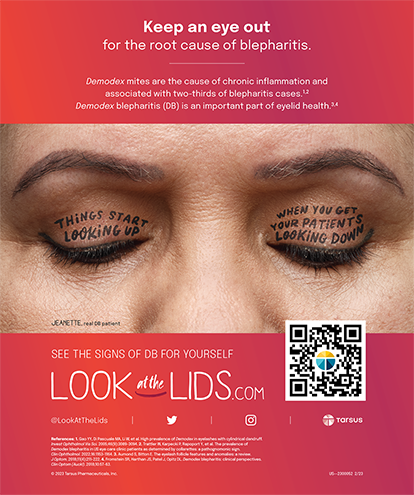
Dissatisfaction After Trifocal IOL Implantation and Its Improvement by Selective Wavefront-Guided LASIK
Seiler TG, Wegner A, Senfft T, Seiler T1
ABSTRACT SUMMARY
Seiler and colleagues identified 42 of 108 consecutive patients (56 of 213 eyes [26%]) who were dissatisfied 1 month after undergoing cataract surgery and the implantation of a trifocal IOL (FineVision, PhysIOL) because of residual refractive error. This error occurred most frequently in the form of refractive astigmatism greater than 0.50 D.
Study in Brief
In this retrospective study, investigators assessed whether selective wavefront-guided LASIK to correct residual refractive error and all higher-order aberrations except for spherical aberration improved patients’ level of satisfaction after cataract surgery and the implantation of a trifocal IOL. The investigators found a clear benefit to this approach.
WHY IT MATTERS
The investigators found residual refractive error to be the main reason for patient dissatisfaction after cataract surgery with the implantation of a multifocal IOL. Successfully addressing this cause of dissatisfaction could increase the adoption of presbyopia-correcting IOLs.
The dissatisfied patients subsequently—and at no charge to them—underwent selective wavefront-guided LASIK with the Amaris 1050 excimer laser system (Schwind eye-tech-solutions). The procedure used a wavefront acquisition technique with the Peramis (Schwind eye-tech-solutions), a combination topographer and aberrometer, to correct all higher-order aberrations except spherical aberration in order to preserve apodization. None of the patients had a posterior capsular opacity or had undergone an Nd:YAG laser capsulotomy.
Seiler and colleagues compared patients’ degrees of satisfaction and refractive errors before and after LASIK. The procedure achieved the refractive target in 98% of patients, and the degree of refractive astigmatism was 0.50 D or less in 93%. Patients’ overall satisfaction increased from 2.1 ±0.8 preoperatively to 3.6 ±0.8 postoperatively (out of 4), and 88% stated that they would choose the procedure again.
DISCUSSION
Multifocal IOLs have become a standard solution to pseudophakic presbyopia.2 Designs include diffractive, refractive, and hybrid technologies. Extended depth of focus lenses are recent additions that induce a certain amount of spherical aberration to increase depth of focus,3,4 and several accommodating lenses are in development.5
Unfortunately, some patients are dissatisfied after receiving presbyopia-correcting IOLs despite an outcome of 20/20 and J1 UCVA. The source of dissatisfaction may be a residual refractive error or a neural processing limitation.6 The study by Seiler et al deals with the former cause.
Other investigators have described the use of laser vision correction to improve patient satisfaction after multifocal IOL implantation and have reported varying levels of success.7,8 This study by Seiler et al is innovative in that treatment addressed not just refractive error but also higher-order aberrations with the exception of spherical aberration. Earlier research did not find a clear benefit with wavefront-guided treatments,9 but Seiler and colleagues, instead of using a Hartmann-Shack aberrometer, used an aberrometer with a pyramidal sensor (Osiris-T, CSO Technologies) that has a higher resolution. This may explain the superior outcomes they reported.
Corneal Crosslinking and Intracorneal Ring Segments for Keratoconus: a Randomized Study of Concurrent Versus Sequential Surgery
Hersh PS, Issa R, Greenstein SA10
ABSTRACT SUMMARY
The purpose of this prospective randomized clinical trial was to compare the safety and efficacy of CXL and the placement of intrastromal corneal ring segments (ICRSs) performed concurrently versus sequentially. Patients (N = 198) were randomly assigned to undergo either ICRS implantation followed immediately by CXL during the same session (n = 104) or ICRS placement followed by CXL 3 months later (n = 94). Main outcome measures were changes in maximum keratometry and the topographic inferior-superior difference, maximum flattening of topographic keratometry, and changes in uncorrected distance visual acuity and corrected distance visual acuity. Analysis was conducted for the entire cohort, the two randomized groups, and subgroups stratified according to ICRS size and placement. Patients were observed for 6 months.
Study in Brief
In a prospective randomized clinical trial, outcomes were equivalent whether CXL was performed immediately or 3 months after the placement of intrastromal corneal ring segments (ICRSs) for the treatment of keratoconus. No reduction in safety was observed.
WHY IT MATTERS
Whether to perform ICRS placement and CXL at the same sitting or sequentially has long been a matter of debate. Based on the results of this study, surgeons can perform ICRS placement and CXL immediately sequentially and thereby hasten patients’ visual recovery, offer them greater convenience, and increase cost-efficiency.
Maximum keratometry decreased by 2.50 D on average. The topographic inferior-superior difference improved by 3.90 D. The average maximum flattening of topographic keratometry was -7.50 D. Uncorrected distance visual acuity improved, on average, by 2.0 logMAR lines, and corrected distance visual acuity improved by 1.1 lines. The investigators found no significant difference in outcomes between the treatment groups.
DISCUSSION
Both ICRS and CXL have been used extensively for the treatment of keratoconus. CXL can halt disease progression,11 whereas ICRSs remodel the cornea.12-28 Combining the two procedures can therefore stop ectatic progression and improve visual acuity. A question long debated, however, is whether the procedures should be performed sequentially or consecutively.
Hersh et al found that both approaches provided equivalent outcomes without a reduction in safety when ICRS placement and CXL were performed at the same sitting. This has practical consequences for surgeons and their patients. Performing ICRS implantation and CXL concurrently saves time, is more cost-effective, and is more convenient for patients.
1. Seiler TG, Wegner A, Senfft T, Seiler T. Dissatisfaction after trifocal IOL implantation and its improvement by selective wavefront-guided LASIK. J Refract Surg. 2019;35(6):346-352.
2. Alió JL, Pikkel J, eds. Multifocal Intraocular Lenses: The Art and the Practice. 2nd ed. Springer Nature; 2019.
3. Kanclerz P, Toto F, Grzybowski A, Alió JL. Extended depth-of-field intraocular lenses: an update. Asia Pac J Ophthalmol. 2020;9(3):194-202.
4. Alió JL. Presbyopic lenses: evidence, masquerade news, and fake news. Asia Pac J Ophthalmol. 2019;8(4):273-274.
5. Alió JL, Alió Del Barrio JL, Vega-Estrada A. Accommodative intraocular lenses: where are we and where we are going. Eye Vis (Lond). 2017;4:16.
6. Alió JL, Pikkel J. Multifocal intraocular lenses: neuroadaptation. In : Alió JL, Pikkel J, eds. Multifocal Intraocular Lenses: The Art and the Practice. 2nd ed. Springer Nature; 2019:53-60.
7. Alió JL, Kaymak H, Breyer D, Cochener B, Plaza-Puche AB. Quality of life related variables measured for three multifocal diffractive intraocular lenses: a prospective randomised clinical trial. Clin Exp Ophthalmol. 2018;46(4):380-388.
8. Maurino V, Allan BD, Rubin GS, Bunce C, Xing W, Findl O, Moorfields Study Group. Quality of vision after bilateral multifocal intraocular lens implantation: a randomized trial—AT LISA 809M versus AcrySof ReSTOR SN6AD1. Ophthalmology. 2015;122(4):700-710.
9. Muftuoglu O, Prasher P, Chu C, et al. Laser in situ keratomileusis for residual refractive errors after apodized diffractive multifocal intraocular lens implantation. J Cataract Refract Surg. 2009;35(6):1063-1071.
10. Hersh PS, Issa R, Greenstein SA. Corneal crosslinking and intracorneal ring segments for keratoconus: a randomized study of concurrent versus sequential surgery. J Cataract Refract Surg. 2019;45(6):830-839.
11. Alifa R, Piñero D, Velázquez J, Alió Del Barrio JL, Cavas F, Alió JL. Changes in the 3D corneal structure and morphogeometric properties in keratoconus after corneal collagen crosslinking. Diagnostics (Basel). 2020;10(6):397.
12. Vega-Estrada A, Alió JL, Brenner LF, et al. Outcome analysis of intracorneal ring segments for the treatment of keratoconus based on visual, refractive, and aberrometric impairment. Am J Ophthalmol. 2013;155(3):575-584.e1.
13. Fariselli C, Vega-Estrada A, Arnalich-Montiel F, Alió JL. Artificial neural network to guide intracorneal ring segments implantation for keratoconus treatment: a pilot study. Eye Vis (Lond). 2020;7:20.
14. Vega-Estrada A, Chorro E, Sewelam A, Alió JL. Clinical outcomes of a new asymmetric intracorneal ring segment for the treatment of keratoconus. Cornea. 2019;38(10):1228-1232.
15. Vega-Estrada A, Alió JL. The use of intracorneal ring segments in keratoconus. Eye Vis (Lond). 2016;3:8.
16. Vega-Estrada A, Alió JL, Plaza-Puche AB. Keratoconus progression after intrastromal corneal ring segment implantation in young patients: five-year follow-up. J Cataract Refract Surg. 2015;41(6):1145-1152.
17. Peña-García P, Alió JL, Vega-Estrada A, Barraquer RI. Internal, corneal, and refractive astigmatism as prognostic factors for intrastromal corneal ring segment implantation in mild to moderate keratoconus. J Cataract Refract Surg. 2014;40(10):1633-1644.
18. Alió JL, Vega-Estrada A, Esperanza S, Barraquer RI, Teus MA, Murta J. Intrastromal corneal ring segments: how successful is the surgical treatment of keratoconus? Middle East Afr J Ophthalmol. 2014;21(1):3-9.
19. Vega-Estrada A, Alió JL, Brenner LF, Burguera N. Outcomes of intrastromal corneal ring segments for treatment of keratoconus: five-year follow-up analysis. J Cataract Refract Surg. 2013;39(8):1234-1240.
20. Peña-García P, Vega-Estrada A, Barraquer RI, Burguera-Giménez N, Alió JL. Intracorneal ring segment in keratoconus: a model to predict visual changes induced by the surgery. Invest Ophthalmol Vis Sci. 2012;53(13):8447-8457.
21. Piñero DP, Alió JL, Barraquer RI, Michael R. Corneal biomechanical changes after intracorneal ring segment implantation in keratoconus. Cornea. 2012;31(5):491-499.
22. Piñero DP, Alió JL, Klonowski P, Toffaha B. Vectorial astigmatic changes after corneal collagen crosslinking in keratoconic corneas previously treated with intracorneal ring segments: a preliminary study. Eur J Ophthalmol. 2012;22(suppl 7):S69-80.
23. Alió JL, Piñero DP, Söğütlü E, Kubaloglu A. Implantation of new intracorneal ring segments after segment explantation for unsuccessful outcomes in eyes with keratoconus. J Cataract Refract Surg. 2010;36(8):1303-1310.
24. Piñero DP, Alió JL. Intracorneal ring segments in ectatic corneal disease – a review. Clin Exp Ophthalmol. 2010;38(2):154-167.
25. Piñero DP, Alió JL, El Kady B, et al. Refractive and aberrometric outcomes of intracorneal ring segments for keratoconus: mechanical versus femtosecond-assisted procedures. Ophthalmology. 2009;116(9):1675-1687.
26. Alió JL, Shabayek MH, Artola A. Intracorneal ring segments for keratoconus correction: long-term follow-up. J Cataract Refract Surg. 2006;32(6):978-985.
27. Alió JL, Shabayek MH. Intracorneal asymmetrical rings for keratoconus: where should the thicker segment be implanted? J Refract Surg. 2006;22(3):307-309.
28. Alió JL, Artola A, Hassanein A, Haroun H, Galal A. One or 2 Intacs segments for the correction of keratoconus. J Cataract Refract Surg. 2005;31(5):943-953.




